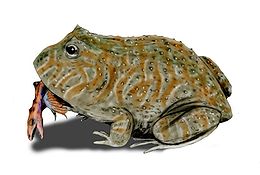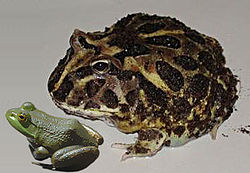- Beelzebufo
-
Beelzebufo
Temporal range: Late Cretaceous, 70 Ma
An artist's depiction of Beelzebufo consuming a theropod. Scientific classification Kingdom: Animalia Phylum: Chordata Class: Amphibia Order: Anura Suborder: Neobatrachia Superfamily: Hyloidea Family: Leptodactylidae Subfamily: Ceratophryinae Genus: Beelzebufo
Evans, Jones, & Krause, 2008Species - B. ampinga Evans, Jones, & Krause, 2008 (type)
Beelzebufo ampinga (pronounced /biːˌɛlzɨˈbjuːfoʊ æmˈpɪŋɡə/, also /ˌbiːlzəˈbjuːfoʊ/) was a particularly large species of prehistoric frog first identified in 2007. Common names assigned by the popular media include "Devil Frog",[1] "Devil Toad",[2] and "The Frog From Hell".[3] Fossils of Beelzebufo have been recovered from strata of the Maevarano Formation in Madagascar, dating to the late Cretaceous Period, some 70 million years ago.[4]
Contents
Etymology
The generic name Beelzebufo is a portmanteau of Beelzebub (a Semitic deity sometimes identified as one of the chief lieutenants, or persona of the Christian Devil) and bufo (Latin for "toad"). The specific name ampinga means "shield" in the language of Malagasy.
Description
The species may have grown to over 40 centimetres (16 in) and 4 kilograms (8.8 lb) — larger than any living frogs, including the largest known species, the goliath frog, which can be up to 32 centimetres (13 in). The bones of the skull roof shows a rugous external surface, indicating that at least parts of the head may have borne scutes.
Biogeography
 Size and shape comparison of Beelzebufo with a typical six inch long American Bullfrog (Rana catesbeiana). Cranwell's horned frog (Ceratophrys cranwelli) is standing in as a model for the former.
Size and shape comparison of Beelzebufo with a typical six inch long American Bullfrog (Rana catesbeiana). Cranwell's horned frog (Ceratophrys cranwelli) is standing in as a model for the former.
Although the fossils of Beelzebufo appear in what is now Madagascar, which, still attached to India, had split from the coast of Somalia in the earliest stage of the late Jurassic,[5] it superficially resembles its closest living relatives, the Ceratophryinae or horned toads of South America, of which the largest today grow to 15 cm (6 in.) long. As West Gondwana (South America) rifted away from East Gondwana, opening from the north and spreading southward, open marine conditions in the widening South Atlantic obtained by about 110 mya, isolating the amphibians on either side; the last common ancestor of Beelzebufo and the South American ceratophryinae is most likely to have existed before that date and probably before seafloor-spreading demonstrates the earlier isolation of Madagascar-India, a very long time undocumented by fossils.[6] Alternatively the history of archaeogeography could be rewritten: Richard Lane, program director in NSF's Division of Earth Sciences, said "The occurrence of this frog in Madagascar and its relatives' existence in South America provides strong evidence that the supercontinent Gondwana 'disassembled' during the latest part of the Cretaceous."[1]
Lifestyle
In comparison with the living horned frogs, Beelzebufo was a predator whose expansive mouth allowed it to eat relatively large prey, perhaps even juvenile dinosaurs.[7] Beelzebufo was probably a dry-land frog, living in arid environments and ambushing prey.
Discovery
The first fossil fragments were found in 1993 by David W. Krause of New York's Stony Brook University, but it took 14 years for scientists Susan E. Evans, Marc E. H. Jones, and Krause to assemble enough data for publication in the Proceedings of the National Academy of Sciences, the journal of the United States National Academy of Sciences. Some 75 fossil fragments have been found. Researchers have been able to reconstruct parts of the frog's skeleton, including nearly the entire skull.
See also
- Demon Duck of Doom
References
- ^ a b Dybas, Cheryl (2008-02-18). "Scientists Discover 'Giant Fossil Frog from Hell'". Press Release 08-025. National Science Foundation. http://www.nsf.gov/news/news_summ.jsp?cntn_id=111119&org=NSF&from=news. Retrieved 2008-02-19.
- ^ "Scientists find 'Devil Toad' fossil". Associated Press. 2008-02-19. http://news.yahoo.com/s/ap/20080219/ap_on_sc/giant_frog;_ylt=AuhcdY7K90.BdBVLjY6chtes0NUE. Retrieved 2008-02-19.[dead link]
- ^ Hooper, Rowan (2008-02-18). "Giant prehistoric frog hints at ancient land link". New Scientist. http://environment.newscientist.com/channel/earth/dn13342-giant-prehistoric-frog-hints-at-ancient-land-link.html. Retrieved 2008-02-19.
- ^ Evans, Susan E.; Jones, Marc E. H.; David W. Krause (2008). "A giant frog with South American affinities from the Late Cretaceous of Madagascar". Proceedings of the National Academy of Sciences of the United States of America 105 (8): 2951–2956. doi:10.1073/pnas.0707599105. PMC 2268566. PMID 18287076. http://www.pubmedcentral.nih.gov/articlerender.fcgi?tool=pmcentrez&artid=2268566.
- ^ Lawrence A. Lawver, Lisa M. Gahagan and Ian w.D. Dalziel, "A tight-fit early Mesozoic Gondwana: a plate reconstruction perspective", 1999, p. 5 "Africa-Madagascar", with citations (on-line text).
- ^ Frogs of Gondwana are only very spottily represented in fossils.
- ^ "'Frog from hell' fossil unearthed". BBC News. 2008-02-18. http://news.bbc.co.uk/2/hi/science/nature/7251666.stm. Retrieved 2008-02-18.
External links
Categories:- Ceratophryinae
- Prehistoric frogs
- Cretaceous amphibians
- Maevarano fauna
- Fossil taxa described in 2008
Wikimedia Foundation. 2010.
